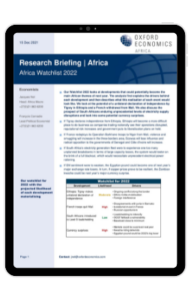Africa Watchlist 2022

Our Watchlist 2022 looks at developments that could potentially become the main African themes of next year. We look at the potential of a unilateral declaration of independence by Tigray in Ethiopia and a French withdrawal from Mali. We also discuss the prospect of South Africans enduring unprecedented levels of electricity supply disruptions and look into some potential currency surprises.
What you will learn:
- If France redeploys its Operation Barkhane troops to Niger from Mali, violence and smuggling will increase in the three-borders area, Ecowas will lose influence and radical opposition to the governments of Senegal and Côte d’Ivoire will increase.
- If South Africa’s electricity generation fleet were to experience one too many unplanned breakdowns in terms of large capacity losses, the system would teeter on the brink of a full blackout, which would necessitate unprecedented electrical power rationing.
- If EM sentiment were to weaken, the Egyptian pound could become one of next year’s major exchange rate losers. In turn, if copper prices prove to be resilient, the Zambian kwacha could be next year’s major currency surprise.
Tags:
Related Services

Post
US Key Themes 2026: Exceptionalism amid fragmentation
US exceptionalism is alive and well, and that won't change in 2026.
Find Out More
Post
Global Key themes 2026: Bullish on US despite AI bubble fears
We anticipate another year of broadly steady and unexceptional global GDP growth, but with some more interesting stories running below the surface.
Find Out More